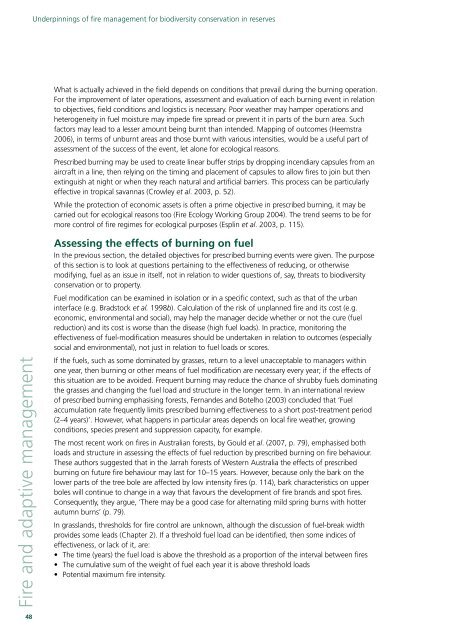Underpinnings of fire management for biodiversity conservation in ...
Underpinnings of fire management for biodiversity conservation in ...
Underpinnings of fire management for biodiversity conservation in ...
You also want an ePaper? Increase the reach of your titles
YUMPU automatically turns print PDFs into web optimized ePapers that Google loves.
48<br />
What is actually achieved <strong>in</strong> the field depends on conditions that prevail dur<strong>in</strong>g the burn<strong>in</strong>g operation.<br />
For the improvement <strong>of</strong> later operations, assessment and evaluation <strong>of</strong> each burn<strong>in</strong>g event <strong>in</strong> relation<br />
to objectives, field conditions and logistics is necessary. Poor weather may hamper operations and<br />
heterogeneity <strong>in</strong> fuel moisture may impede <strong>fire</strong> spread or prevent it <strong>in</strong> parts <strong>of</strong> the burn area. Such<br />
factors may lead to a lesser amount be<strong>in</strong>g burnt than <strong>in</strong>tended. Mapp<strong>in</strong>g <strong>of</strong> outcomes (Heemstra<br />
2006), <strong>in</strong> terms <strong>of</strong> unburnt areas and those burnt with various <strong>in</strong>tensities, would be a useful part <strong>of</strong><br />
assessment <strong>of</strong> the success <strong>of</strong> the event, let alone <strong>for</strong> ecological reasons.<br />
Prescribed burn<strong>in</strong>g may be used to create l<strong>in</strong>ear buffer strips by dropp<strong>in</strong>g <strong>in</strong>cendiary capsules from an<br />
aircraft <strong>in</strong> a l<strong>in</strong>e, then rely<strong>in</strong>g on the tim<strong>in</strong>g and placement <strong>of</strong> capsules to allow <strong>fire</strong>s to jo<strong>in</strong> but then<br />
ext<strong>in</strong>guish at night or when they reach natural and artificial barriers. This process can be particularly<br />
effective <strong>in</strong> tropical savannas (Crowley et al. 2003, p. 52).<br />
While the protection <strong>of</strong> economic assets is <strong>of</strong>ten a prime objective <strong>in</strong> prescribed burn<strong>in</strong>g, it may be<br />
carried out <strong>for</strong> ecological reasons too (Fire Ecology Work<strong>in</strong>g Group 2004). The trend seems to be <strong>for</strong><br />
more control <strong>of</strong> <strong>fire</strong> regimes <strong>for</strong> ecological purposes (Espl<strong>in</strong> et al. 2003, p. 115).<br />
Assess<strong>in</strong>g the effects <strong>of</strong> burn<strong>in</strong>g on fuel<br />
In the previous section, the detailed objectives <strong>for</strong> prescribed burn<strong>in</strong>g events were given. The purpose<br />
<strong>of</strong> this section is to look at questions perta<strong>in</strong><strong>in</strong>g to the effectiveness <strong>of</strong> reduc<strong>in</strong>g, or otherwise<br />
modify<strong>in</strong>g, fuel as an issue <strong>in</strong> itself, not <strong>in</strong> relation to wider questions <strong>of</strong>, say, threats to <strong>biodiversity</strong><br />
<strong>conservation</strong> or to property.<br />
Fuel modification can be exam<strong>in</strong>ed <strong>in</strong> isolation or <strong>in</strong> a specific context, such as that <strong>of</strong> the urban<br />
<strong>in</strong>terface (e.g. Bradstock et al. 1998b). Calculation <strong>of</strong> the risk <strong>of</strong> unplanned <strong>fire</strong> and its cost (e.g.<br />
economic, environmental and social), may help the manager decide whether or not the cure (fuel<br />
reduction) and its cost is worse than the disease (high fuel loads). In practice, monitor<strong>in</strong>g the<br />
effectiveness <strong>of</strong> fuel-modification measures should be undertaken <strong>in</strong> relation to outcomes (especially<br />
social and environmental), not just <strong>in</strong> relation to fuel loads or scores.<br />
If the fuels, such as some dom<strong>in</strong>ated by grasses, return to a level unacceptable to managers with<strong>in</strong><br />
one year, then burn<strong>in</strong>g or other means <strong>of</strong> fuel modification are necessary every year; if the effects <strong>of</strong><br />
this situation are to be avoided. Frequent burn<strong>in</strong>g may reduce the chance <strong>of</strong> shrubby fuels dom<strong>in</strong>at<strong>in</strong>g<br />
the grasses and chang<strong>in</strong>g the fuel load and structure <strong>in</strong> the longer term. In an <strong>in</strong>ternational review<br />
<strong>of</strong> prescribed burn<strong>in</strong>g emphasis<strong>in</strong>g <strong>for</strong>ests, Fernandes and Botelho (2003) concluded that ‘Fuel<br />
accumulation rate frequently limits prescribed burn<strong>in</strong>g effectiveness to a short post-treatment period<br />
(2–4 years)’. However, what happens <strong>in</strong> particular areas depends on local <strong>fire</strong> weather, grow<strong>in</strong>g<br />
conditions, species present and suppression capacity, <strong>for</strong> example.<br />
The most recent work on <strong>fire</strong>s <strong>in</strong> Australian <strong>for</strong>ests, by Gould et al. (2007, p. 79), emphasised both<br />
loads and structure <strong>in</strong> assess<strong>in</strong>g the effects <strong>of</strong> fuel reduction by prescribed burn<strong>in</strong>g on <strong>fire</strong> behaviour.<br />
These authors suggested that <strong>in</strong> the Jarrah <strong>for</strong>ests <strong>of</strong> Western Australia the effects <strong>of</strong> prescribed<br />
burn<strong>in</strong>g on future <strong>fire</strong> behaviour may last <strong>for</strong> 10–15 years. However, because only the bark on the<br />
lower parts <strong>of</strong> the tree bole are affected by low <strong>in</strong>tensity <strong>fire</strong>s (p. 114), bark characteristics on upper<br />
boles will cont<strong>in</strong>ue to change <strong>in</strong> a way that favours the development <strong>of</strong> <strong>fire</strong> brands and spot <strong>fire</strong>s.<br />
Consequently, they argue, ‘There may be a good case <strong>for</strong> alternat<strong>in</strong>g mild spr<strong>in</strong>g burns with hotter<br />
autumn burns’ (p. 79).<br />
In grasslands, thresholds <strong>for</strong> <strong>fire</strong> control are unknown, although the discussion <strong>of</strong> fuel-break width<br />
provides some leads (Chapter 2). If a threshold fuel load can be identified, then some <strong>in</strong>dices <strong>of</strong><br />
effectiveness, or lack <strong>of</strong> it, are:<br />
• The time (years) the fuel load is above the threshold as a proportion <strong>of</strong> the <strong>in</strong>terval between <strong>fire</strong>s<br />
• The cumulative sum <strong>of</strong> the weight <strong>of</strong> fuel each year it is above threshold loads<br />
• Potential maximum <strong>fire</strong> <strong>in</strong>tensity.<br />
Fire and adaptive <strong>management</strong> <strong>Underp<strong>in</strong>n<strong>in</strong>gs</strong> <strong>of</strong> <strong>fire</strong> <strong>management</strong> <strong>for</strong> <strong>biodiversity</strong> <strong>conservation</strong> <strong>in</strong> reserves





![Metcalfe State Forest Fauna Species List [PDF File - 16.9 KB]](https://img.yumpu.com/22024301/1/184x260/metcalfe-state-forest-fauna-species-list-pdf-file-169-kb.jpg?quality=85)






![PPE Price List for Wildlife Volunteers [PDF File - 20.3 KB]](https://img.yumpu.com/15321634/1/190x135/ppe-price-list-for-wildlife-volunteers-pdf-file-203-kb.jpg?quality=85)




